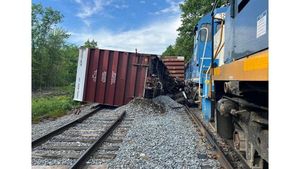The HTS militia's ascent marks a pivotal shift in Syria as it now controls nearly 70 percent of the country following the recent flight of dictator Bashar al-Assad.
Two months have passed since this significant takeover, which has left many wondering about the future governance of Syria as HTS establishes its influence over the regions once dominated by the Assad regime. With Assad fleeing, the rebels are working to solidify their power.
This reshaping of power dynamics has not gone unnoticed, as the Weltspiegel team recently traversed through these tumultuous territories to grasp the changes first-hand. The atmosphere is charged with tension as the aftermath of the Syrian civil war continues to manifest new challenges and opportunities for both the local population and the international community.
Originally regarded as mere insurgents, HTS's control marks not only the decline of Assad’s regime but also signals the rising influence of Islamist militant factions within the region. This control defines the present state of Syria, leaving vast parts of the country seeking stability under HTS's rule.
The fall of Assad's influence has led to various reactions among the Syrian populace. Some communities express hope for change, eager for the potential of new governance under HTS, who promise to restore order. Others remain skeptical of the militia’s intentions, fearing they might enforce strict Islamic law and curtail freedoms previously enjoyed by locals.
Assad's flight has opened the gateway for these conversations about future governance. HTS has begun establishing local councils to manage daily affairs, aiming to project an image of legitimacy and civility among the war-torn population, contrasting sharply with the previous regime’s often brutal tactics.
Foreign observers and regional analysts are dissecting the event’s ramifications. The HTS's control could lead to broader regional instability, drawing skeptical views from other nations wary of Islamist governance. Analysts are keeping close tabs on HTS's next strategies and the potential ripple effects across other parts of the Middle East.
Meanwhile, the Weltspiegel team noted the visible change on the ground, ranging from the infrastructure needs to the palpable desires for peace. Initially greeted by wary locals, the team built rapport to shed light on the everyday realities of this significant power transition.
The conversations with residents unveiled myriad opinions about HTS’s ability to govern fairly after amid the years of chaos ignited by the civil war. Some residents expressed relief concerning the oppressive rule of the Assad regime being lifted, whilst others voiced their fears of HTS's radical views.
Although many are ready to embrace the notion of stability, the presence of armed militia adds to their concerns, as does the uncertain future facing the nation. The residents seek to reclaim normalcy, and some express hope for international recognition of HTS, wishing for economic support to rebuild their homes and lives.
The international community faces tough questions as they adapt to the changing control within Syria. Nations supportive of Assad are now reassessing their posture, wary of HTS's growing influence. Aid organizations and foreign governments may find it challenging to navigate the complex dynamics brought on by HTS’s control.
Overall, the situation as reported by Weltspiegel paints the portrait of both hope and simmering tensions. The HTS's rise is emblematic of the unrest and transformative struggles prevalent across Syria for over a decade.
With past gains, the HTS's consolidation of power remains under scrutiny as the nation learns to adapt to newly rapid changes.
Assad's fleeing has set the stage for HTS to shape Syria's future, but how this will evolve remains to be seen. Will HTS bring lasting change or merely extend the turmoil?



